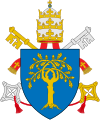The Creation of the Sun, Moon, and Plants
| The Creation of the Sun, Moon and Vegetation | |
|---|---|
 | |
| Artist | Michelangelo |
| Year | 1511 |
| Type | Fresco |
| Dimensions | 280 cm × 570 cm (110 in × 220 in) |
| Location | Sistine Chapel, Vatican City |
The Creation of the Sun, Moon and Vegetation, (sometimes The Creation of the Sun, Moon, and Plants[1] or The Creation of the Sun and the Moon) is one of the frescoes from Michelangelo's nine Book of Genesis scenes on the Sistine Chapel ceiling. It is the second scene in the chronological sequence on the ceiling, depicting the third and fourth day of the Creation narrative. On the left, God is depicted from behind, extending his arm towards a bush, alluding to the plant world. On the right, God points and divides the sun and moon in the heavens (or hurls them into orbit). The faint moon is on the right side, touched by the God's left hand. The God's face expresses the stupendous force needed for the creation of the abode of living beings. The abstract patterns of drapery emphasize the motion of both figures of God.
The Creation of the Sun, Moon and Planets is featured on the postage stamps of Vatican City (issue of 1994) and India (issue of 1975).

.
References
- ^ "Creation of the Sun, Moon, and Plants". Web Gallery of Art. Retrieved 13 Jan 2014.

